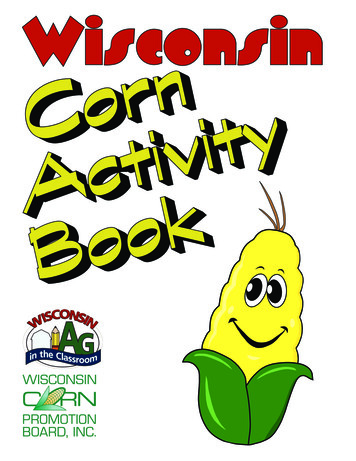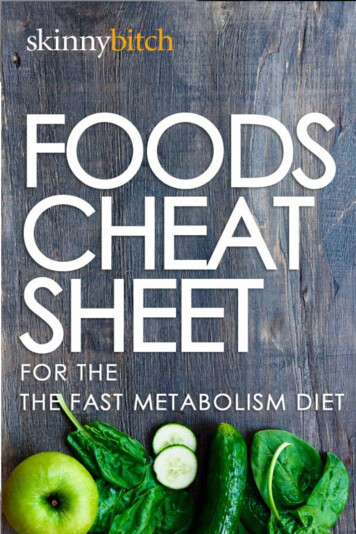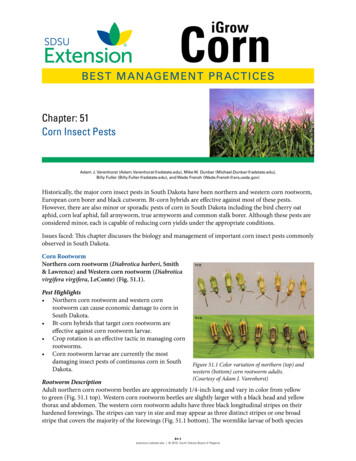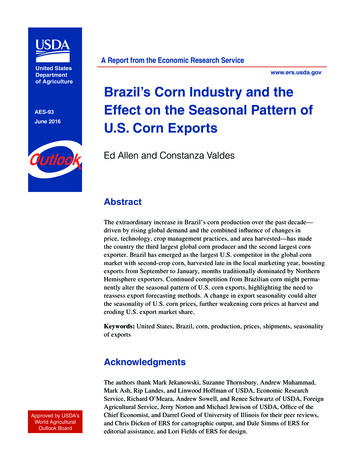
Transcription
SS-AGR-85doi.org/10.32473/edis-ag202-2022Field Corn Production Guide1David Wright, Ian Small, Cheryl Mackowiak, Zane Grabau, Pratap Devkota, and SilvanaPaula-Moraes2The recent national corn yield contests have shown yieldpotential of irrigated corn to be 500 bu/acre with currentcorn hybrids in the southeastern United States. Factorsthat can result in less-than-optimum yield for corn includestress caused by too little or too much moisture, lack offertility at certain growth stages, and nonoptimal heat orlight intensity. Each of these factors, along with pest problems, can chip away at the yield potential of the hybrid, withFlorida average yields being about 25% of what regionalcontest winners make.Field corn is important in Florida for both grain and silage.Corn is used widely in the dairy and livestock industriesand is risky to grow without irrigation. Florida has regainedsome of the lost infrastructure for handling, drying, andstorage. Corn acreage in Florida was around 400,000 acresin the 1970s (Figure 1). By the late 1980s, acreage haddeclined to about 100,000 acres. Acreage has averagedaround 100,000 acres in recent years. However, yields haveincreased over that same timeframe from about 45 bu/acto 120 bu/ac. In the late 1970s and early 1980s, irrigatedacres increased dramatically. High corn prices with theethanol boom resulted in the installation of many newirrigation wells and pivots for both corn and peanut. Highcorn demand for ethanol production resulted in an increasein acreage and price across the United States. Corn is stillgrown profitably in rotation with cotton and peanut, withyield benefits to each of the crops in the rotation. However,irrigation is essential to attain profitable corn yields.Figure 1. Historical corn acres planted (top), produced (middle), andyield (bottom) in Florida.Credits: https://quickstats.nass.usda.gov1. This document is SS-AGR-85, one of a series of the Agronomy Department, UF/IFAS Extension. Original publication date January 2004. Revised July2011, December 2014, November 2017, and August 2022. Visit the EDIS website at https://edis.ifas.ufl.edu for the currently supported version of thispublication.2. David Wright, Extension specialist, cropping systems and conservation tillage, and professor, Agronomy Department, UF/IFAS North Florida Researchand Education Center, Quincy, FL; Ian Small, assistant professor, plant pathology, UF/IFAS NFREC; Cheryl Mackowiak, associate professor, nutrientmanagement and water quality, Department of Soil, Water, and Ecosystem Sciences, UF/IFAS NFREC; Zane Grabau, assistant professor, Entomologyand Nematology Department; Pratap Devkota, assistant professor, weed science, UF/IFAS West Florida Research and Education Center; and SilvanaPaula-Moraes, assistant professor, crop pest management, UF/IFAS WFREC; UF/IFAS Extension, Gainesville, FL 32611.The Institute of Food and Agricultural Sciences (IFAS) is an Equal Opportunity Institution authorized to provide research, educational information and other servicesonly to individuals and institutions that function with non-discrimination with respect to race, creed, color, religion, age, disability, sex, sexual orientation, marital status,national origin, political opinions or affiliations. For more information on obtaining other UF/IFAS Extension publications, contact your county’s UF/IFAS Extension office.U.S. Department of Agriculture, UF/IFAS Extension Service, University of Florida, IFAS, Florida A & M University Cooperative Extension Program, and Boards of CountyCommissioners Cooperating. Andra Johnson, dean for UF/IFAS Extension.
EconomicsCorn can be produced economically in Florida as a grain orsilage crop. Budgets are available at ndex.html.Land PreparationA good soil management program protects the soil fromwater and wind erosion, provides a weed-free seedbed forplanting, disrupts compacted layers that may limit rootdevelopment, and allows maintenance or an increase oforganic matter. Strip-tillage into killed cover crops, wintergrazing, or old crop residue helps to meet all of theseobjectives.Water erosion is a significant problem on all tilled soiltypes that have no cover crops during the high-rainfallwinter months. Wind erosion can be a problem on sandyCoastal Plain soils in early spring when blowing sand canseverely injure young corn plants. Crop residue left on thesoil surface or a cover crop effectively reduces water andwind erosion. Using minimum-till planting practices withhigh-residue cover crops or following winter grazing helpsreduce soil loss and “sand blasting” from wind erosion.Conservation tillage is a widely accepted practice in southeastern crops, including corn. Strip-tillage leaves variousamounts of crop residue or cover crop on the surface,improving water infiltration and reducing soil erosion.Strip-tilling into a previous crop residue or cover cropis effective as long as the seedbed is not rutted from theprevious harvesting operation or washed out by heavyrains. It is desirable to kill cover crops several weeks aheadof planting to reduce competition from the cover crop andto reduce cutworm and southern corn rootworm damageto young corn seedlings. However, many corn producershave cattle that graze these fields up until the day corn isplanted. In this case, planting into live root systems occurs.Therefore, insecticides to protect the young corn seedlingsfrom cutworm and other soil insect damage, or varietieswith genetic technology that provides resistance to thesepests should be used. Insects are seldom a severe problemif cover crops have been killed 3–4 weeks prior to planting.However, planting corn after winter grazing results inhigher nutrient availability to the corn crop in the soil.Recent research shows larger root systems following wintergrazing, which can translate into higher yields.Mulch from killed pasture grass or crop residue conservesmoisture. Strip-till corn often yields more than conventional-tilled, non-irrigated corn in years when moisture islimited (Table 1). Effective erosion control needs residue ofField Corn Production Guideat least 3,000 pounds per acre. Research has shown that thepresence of more residue increases the moderation of soiland plant canopy temperatures and improves the conservation of moisture. Water is usually the main limiting factorto corn yield in Florida unless irrigation is provided.A compaction layer occurs naturally on Coastal Plain soils.This compacted layer restricts root growth as well as waterand nutrient uptake by the plant. It should be disruptedby chisel plowing, or with an in-row subsoiler at planting.In-row subsoiling has increased corn yields over 50% onsoils where no or limited irrigation occurs (Tables 2 and3). Subsoiling enables corn to develop deeper root systemsthat make better use of subsoil moisture and improves thechances of recovering nutrients as they move through thesoil.Corn generally grows best in deep, well-drained soils,although good yields have been obtained on a wide varietyof soil types with irrigation. Land preparation to warmup soils is not necessary for corn, because corn is not assensitive to cold soils as many other crops.Hybrid SelectionGrowers have one chance to make the right decisionregarding the corn hybrid to use each year. Differencesamong hybrids in yield potential, maturity, standability,disease resistance, grain quality, and adaptability can beobtained from university performance trials. For irrigatedor non-irrigated corn production, performance trials conducted in locations closest to the farm should be studied.Growers should use 2–3 of the best hybrids because hybridsdo not perform identically under all conditions.Disease resistance is a necessary component of hybridselection for the South. Higher humidity, fluctuating wateravailability, and higher plant populations under irrigationwill favor many diseases. Hybrids should have resistanceto southern corn leaf blight, anthracnose, gray leaf spot,common rust, southern rust, etc. Corn planted after cornis especially susceptible to leaf diseases because there is abuildup of spores throughout the growing season. Bt cornsurvives later planting because of insect resistance, but itmay fail to produce grain due to little disease resistance.There are several fungicides labeled for corn that should beconsidered if disease is found soon after tasseling. Grainquality depends on shuck coverage and grain hardness toretain moisture and inhibit insect penetration into the ear.Corn maturity is classified as early (short-season),medium (mid-season), or late (full-season). In general, the2
earliest-maturing hybrids best adapted to Florida matureabout 115 days after emergence. Maturity will range upto 125 days for full-season hybrids. Early- and mediummaturing hybrids are usually better adapted to irrigatedcorn production because: they mature 1–2 weeks earlier;are generally shorter and less subject to lodging; may needfewer irrigations; and are more suitable for use in doublecropping than late or full-season hybrids. However, fullseason “tropical” hybrids are often grown after early-seasoncorn hybrids for silage. If the farm workload normallyprevents harvesting early- to medium-maturing hybridswithin 30 days after physiological maturity (black layer),consider planting a later-maturing hybrid, which normallyhas better shuck coverage.Results of hybrid evaluation tests for grain and silage areavailable from the web and county UF/IFAS Extensionoffices. Hybrid evaluation information is available on theUniversity of Georgia website (http://www.swvt.uga.edu/).Consistent performance across several locations and yearsusually means better yield stability. It is important, however,to compare hybrids within maturity groups. Growersshould test new hybrids on their farms but should not plantan untried hybrid to large acreages.Primary selection criteria when choosing a hybrid includethe following: Grain yield Maturity Stalk strength Grain quality and disease and insect resistance Silage yield and digestibilityMost hybrids are available with herbicide and insect traitsthat give value for pest control. These traits include multipleBt traits for insect resistance and those with resistance toherbicides such as Roundup, Ignite, IMI (imidazolinone),and others. High-oil content corn hybrids are also availablefor planting in the Southeast. Because they are pricedhigher than conventional hybrids, these hybrids should beused only where the specific trait is of economic benefit.Late-planted (May–July) corn should have the Bt gene forinsect control.Planting Growth and DevelopmentTo produce good irrigated corn yields, timely managementand an understanding of how corn grows and develops arenecessary. Although growth rates vary among hybrids andField Corn Production Guidegrowing conditions, Table 4 is a general outline of corndevelopment for a medium-maturity hybrid in Florida.Planting DateCorn growth and development are primarily dependent ontemperature rather than day length. Successful germinationrequires a morning soil temperature of 55 F at a 2-inchdepth for three consecutive days. This can range from earlyFebruary in light sandy soils to mid-March on heavy soils.Frost may still occur after these planting dates, but cornnormally withstands frost damage to aboveground tissue,because the growing point is still below the soil surfaceuntil corn reaches a height of about 12 inches.In Florida, planting dates for corn begin in late Februaryand proceed to late April. Corn may be planted in late Julyor early August as a second crop.Advantages to early planting include: More stored soil moisture Higher yield potential Lower temperatures during pollination Longer day lengths at pollination Early harvest before cotton and peanuts Less insect and disease pressureWhen moisture is adequate, plant seed between 1 and 2inches deep. When soil moisture is deeper than 2.5 inches,waiting for a rain or irrigating may improve stands. In coldsandy soil, the depth may need to be closer to 1–1.5 inches.Germination time and emergence will vary with moistureand temperature from 5 to 30 days.Table 5 shows irrigated corn yield data from two locationsaveraged over several hybrids. Irrigated yields tend to befairly consistent from February through April, and thendecline after April due to insect damage and disease.However, tropical hybrids with insect resistance genes canproduce high yields into June. Non-irrigated corn may dobest during late-April planting if normal rainfall occursin July and August. Non-irrigated corn is at risk each yearbecause dry periods of three weeks or longer often occur.Plant Populations and Row SpacingThe optimum plant population varies with soil type, hybrid,irrigation, fertility, and other management practices.Optimal yields are achieved when emergence and plantspacing are uniform—so-called “photocopies and picketfences.” Irrigated corn requires higher plant populations3
than non-irrigated corn to fully utilize the potential of irrigation. Seeding rates depend on the hybrid, yield expectations, and row width. Recommended plant populations fornon-irrigated corn range from 16,000 to 24,000 plants/acre.Seeding rates for irrigated production usually range from24,000 to 34,000 plants/acre. Seed companies normallyprovide a recommended population for each hybrid.Generally, 24,000–32,000 plants/acre are recommended formost early- and medium-maturing hybrids with irrigation.Plant populations for the later-maturing hybrids should be22,000–26,000 plants/acre. Excessive populations increaseseed costs and may reduce yield due to inadequate wateringor rainfall and lodging. Plant 10%–15% more seed/acrethan is necessary to produce the desired plant population.Corn seed generally germinates at the rate of about 95%;another 5%–10% may be lost to insects, disease, or otherpests.At high plant populations, studies reveal that increasedyields can be obtained with narrower rows. Greater spacebetween plants allows the plants to exploit moisture,nutrients, and light. It also helps weed control by shadingthe ground more quickly. Row widths of 30–36 inches areadequate for top-irrigated yields. In some studies, twin rowyields have shown to yield 5%–10% higher than single rows;however, water and other factors usually limit yield morethan plant population.FertilizationA good fertility program should be based on the soilfertility level as determined by soil tests and yield goal.Fertilization programs not based on soil tests may resultin excessive and/or suboptimal rates of nutrients beingapplied. Soil samples should be taken each fall to monitorfertility level and lime requirements.Coastal Plain soils are naturally acidic and infertile.Therefore, substantial quantities of lime and fertilizer arerequired for optimum yields. Corn cut for silage requiresmore nutrients than corn grown for grain because cuttingsilage removes all of the nutrients from the field in theaboveground plant parts. The removal of potassium isespecially large in comparison to grain harvest. Table 7gives a comparison of the nutrients contained in grain andstover. Figure 2 shows nutrient uptake patterns that weredetermined for high-yielding corn in Illinois.To get population/acre, count the number of seeds inone row for the indicated distance (Table 6) and multiplythis number by 1,000. Check several rows to be certaineach planter unit is working properly. It is always best todouble-check the planter to ensure seed drop is providingthe desired populations. Vacuum planters have excellentcontrol in attaining desired seed drop and plant populations. Whether old or new, well-maintained planters arenecessary for evenly distributed plant populations.If corn is being produced without irrigation, a yield goalof no more than 125 bushels per acre should be set. Underthese conditions, aim for lower plant populations. Choosemanagement practices accordingly. For sandy soils withlimited irrigation, use th
Field corn is important in Florida for both grain and silage. Corn is used widely in the dairy and livestock industries and is risky to grow without irrigation. Florida has regained some of the lost infrastructure for handling, drying, and storage. Corn acreage in Florida was around 400,000 acres in the 1970s (Figure 1). By the late 1980s .










